

How to Prevent People from Tripping on Stairs
It happens to a lot of people. One minute you think that you’ve seen the first rise in the staircase, and then the next minute you’re writhing in pain because you stubbed your toe. But, if you think about it, a stubbed toe is a whole lot better than falling forward on the steps of a staircase.
This is the danger of climbing a staircase that isn’t as visible to the eye. Many people fail to gauge their distance from the first step because they can’t see it clearly. So, if you’re building commercial stairs in Melbourne or if you want to report to your company that you stubbed your toe at the office stairs, you should keep in mind that visible steps are the key to preventing injuries.
Here’s how you can do that.
Clean the steps first
Before you start putting on visibility strips or any other marker on your staircase, make sure that you clean it first. According to experts, clean surfaces tend to have greater contrast, so they’re easier to be seen by the naked eye. Remove all the dirt, rubble, grease, and smudges on your stairs.
Light it up
The next step is to set up proper lighting in the staircase . Some people prefer to keep the light in the hallways and staircase the same to have a uniformed effect. But in doing so, it might be hard for some people to notice the change in elevation or formation of the surface they’re walking on.
What you can do is increase the wattage of the light bulbs in the staircase. This way, people will notice a slight change to the intensity of the light and perhaps make them focus more on what the light is trying to illuminate.
If you’re going to choose a light bulb, go with a low glare type and install it overhead, directly focusing on the steps. This way, the light won’t cast shadows on the stair treads and the nosing, which is often the part of the stairs where people trip on.
Contrast the nosing

The nosing of the stairs is often the danger area of the staircase. Many people trip over this part of the stairs because they fail to gauge its distance from them. Some experts say that one of the probable reasons for this is that some stairs are uniformed in colour, making it hard to see clearly the nosing.
Paint the nosing a different colour to make it stand out from the rest of the step. Pick a colour that will contrast with the colour of the step and use that to paint the nosing.
Put up a sign
Finally, the surest way to let people know that they’re about to either climb up a flight of stairs or climb down is to put up a sign that will tell them so. Installing a sign near the stairs will immediately alert people that they’re about to ascend or descend. So they’ll be more careful with their step.
Visibility is important when it comes to climbing up or down the stairs. One trip can lead to an injury or something even worse. Make sure that you implement the steps above in order to prevent any accidents.
About The Author
Howard Fienberg

Stay Connected
This site is made possible by member support . ❤️
Big thanks to Arcustech for hosting the site and offering amazing tech support.
When you buy through links on kottke.org, I may earn an affiliate commission. Thanks for supporting the site!
kottke.org. home of fine hypertext products since 1998.
🍔 💀 📸 😭 🕳️ 🤠 🎬 🥔
The Art and Science of Tripping Up the Stairs
This is a short video of a set of subway stairs in Brooklyn where one of the steps is juuuust a bit taller than the rest, which makes most people trip on it.
We don’t often think about it but even the least graceful humans move in a finely calibrated way. When we’re climbing stairs, our feet don’t clear the treads by much, so that even the tiniest deviation in the height of a step can spell trouble.
I’d love to see a study of how quickly our bodies learn how high the steps are in a new flight of stairs. Like, maybe we clear the first couple of steps by an inch or two but then we’re locked in and subsequent clearances are much smaller.
Is there a word for the way people tend to speed up after they trip climbing stairs? The stumble hustle? It’s such a small & endearing little thing that most people do.
My least favorite flight of stairs in the entire NYC subway system are, I believe, at the SW corner of 14th St and 6th Ave in Manhattan. Each of the steps is a different height, making for a tricky ascent and a downright dangerous descent. I keep thinking they’re gonna get fixed, but I used them on my last visit to the city in June. At this point, they’re like an old friend who’s kind of a jerk but you’ve known him so long that whaddya gonna do? (via @fishtopher )
Update: On Twitter, André Filipe Barro shared the Brazilian phrase for speeding up after tripping up the stairs : “went on a chicken chase”. Excellent!
Physical Address
304 North Cardinal St. Dorchester Center, MA 02124

10 Crucial Stair Safety Tips to Prevent Slips, Trips and Falls
- January 26, 2024
- General Health
A crucial component of designing homes and public spaces is stair safety, which is frequently disregarded until an accident happens. It is crucial to put safety first because trips, slips, and falls on stairs can result in serious injuries. Ten essential stair safety tips will be covered in this guide, along with detailed explanations and examples from real-world situations to highlight each one’s importance.
10 Crucial Stair Safety Tips
1. Keep Stairs Clear

Maintain Clear Stairs Make sure there are no obstructions, mess, or debris on the staircase. Toys, shoes, and other objects that could cause a trip are all included in this. Users have a safe path and a lower chance of accidents when there is a clear staircase.
Example: Make sure there are no toys, shoes, or bags on the staircase. A child’s toy left on a step, for example, could cause someone using the stairs to trip and fall.
2. Make Use of Proper Lighting
Good lighting is essential for seeing on stairs. To light up the entire staircase, install bright lights at regular intervals. This makes it easier for users to see each step, which lowers the risk of falls or missteps, especially in poorly lit areas.
For instance, add brilliant LED lighting to the stairwell. Without enough lighting, particularly in the evening or early morning, a person may not notice a step, which could result in a misstep and a possible fall.
3. Put in Handrails
When descending or climbing stairs, sturdy handrails provide essential stability and support. Ensure that handrails are at a user-friendly height and are firmly fixed to the wall. A dependable point of contact for preserving balance is offered by handrails.
Example: Installing a sturdy handrail is a good idea if your staircase isn’t equipped with one. A safe handrail would prevent accidents, for example, if an elderly family member relies on it for balance.
4. Safe Carpets and Rugs
Make sure all carpets and rugs on your staircase are firmly attached. Hazards for tripping may result from frayed or loose edges. To reduce the chance of slipping, use adhesives or non-slip backing to keep them in place.
For instance, use carpet tape to secure the edges of any runner carpet you may have on the stairs. Someone could easily trip over a loose carpet, particularly if their foot catches on an elevated corner.
5. Put on Appropriate Footwear
When using stairs, wear shoes with non-slip soles. High-heeled shoes should be avoided as they can be unsteady on stairs. A worn-out sole decreases traction, which raises the possibility of slipping. Select footwear that offers both stability and traction.
Example: Rather than walking in socks, opt for sneakers with a non-slip sole. On hardwood stairs, socks make you more likely to slip; non-slip shoes offer superior traction.
6. Pay Attention to Your Step
When using the stairs, exercise caution. Steer clear of distractions like texting or toting heavy objects that block your field of vision. Being aware of your surroundings lessens the chance that you will trip or lose your balance.
Example: When using the stairs, refrain from distractions like texting. For example, if you glance at your phone while walking, you run the risk of making a mistake and falling.
7. One Step at a Time, Please
Take your time and carefully ascend or descend the stairs. Rushing makes it more likely that you will lose your balance and fall. Better control and stability can be achieved by taking one step at a time, particularly on steep or uneven staircases.
Example: Carefully ascend or descend the stairs, paying attention to each step. Falling is more likely when someone is rushing down the stairs, especially in a hurry.
8. Children Should Learn About Stair Safety

Teach kids the value of using handrails, going one step at a time, and staying away from rough play on stairs. In particular, supervision is essential for younger children who might not fully understand the potential hazards associated with stairs.
As an illustration, teach kids to play nicely on the stairs and to hang onto the handrail. For instance, mention how playing or running on the stairs can cause mishaps.
9. Regular Maintenance
Check stairs frequently for damage, wear, and loose parts. Look for indications of material deterioration or structural problems. To guarantee the staircase’s continued integrity and safety, any issues should be resolved right away.
Example: Frequently inspect steps and railings for damage or looseness. Tightening a loose railing as soon as you see it reduces the chance of a collapse and possible injuries.
10. Install Anti-Slip Treads
If your stairs are constructed of materials that can easily become slippery, you may want to think about installing anti-slip treads. These treads add another degree of traction, which lowers the possibility of slipping, especially in places where there may be moisture.
Example: If your stairs are tile or wood, install anti-slip treads using adhesive. More traction from these treads lowers the possibility of slipping, particularly in damp areas.
Making stair safety a top priority is essential to establishing a safe space. You can improve the safety of your stairs and help avoid trips, falls, and slips by putting these ten essential stair safety tips into practice. Recall that everyone who uses the stairs can benefit from a proactive approach to stair safety, which can prevent accidents and enhance their well-being. To guarantee a safer living or working environment, practice good safety practices, maintain stairs well, and remain watchful.
- Occupational slips trips and falls on the same level: https://www.ncbi.nlm.nih.gov/pmc/articles/PMC5078727/
- Fall prevention research and practice: a worker safety approach: https://www.ncbi.nlm.nih.gov/pmc/articles/PMC4246530/
Trending now

The Neuro Visual Center of New York
Specializing in the Optometric Treatment of Headaches and Dizziness
Bumping Into Walls? Tripping and Falling? It Could Be More Than Clumsiness
September 17, 2018
Are you known as the klutz in your family? Do you routinely bump into doorways, walk into walls or trip over your own feet? While many people just accept this trait as part of their genetic makeup and move on, there are others who are so klutzy that they become stressed and anxious, not knowing when their next bout of clumsiness is going to strike and fearful of possible injury. In many cases, people who experience these issues are not innately clumsy at all: they’re suffering from a medical condition known as vertical heterophoria.
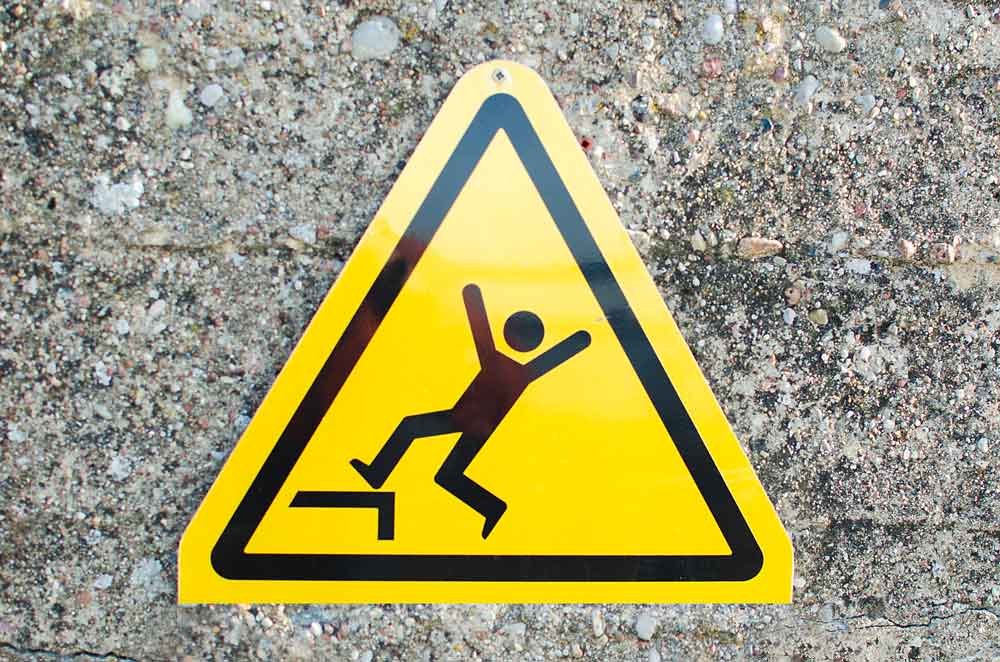
How Vertical Heterophoria Contributes to Clumsiness
Vertical heterophoria (VH) is a binocular vision dysfunction that affects how the eyes work together as a team. With VH, the vertical alignment of the eyes is off-kilter, with one of them being higher than the other. This makes it extremely hard for the eyes to focus on the same place, resulting in poor stereo vision (the combining of two separate images from each eye into one 3D image). Inferior stereo vision in turn leads to poor spatial awareness and depth perception, as evidenced by this testimonial shared by N.S., one of our patients:
“My family would always tease me about how clumsy I was. I couldn’t even walk in a straight line. This got worse as I got older until I tripped and fell in the subway. I became so nervous to go out because I couldn’t walk straight or judge how to step off a curb. I consulted many doctors who diagnosed me with anxiety disorder. I really didn’t think I had anxiety disorder at all. I was anxious because I was afraid I was going to fall due to my poor depth perception. I learned about Dr. Debby Feinberg’s work from the internet and was excited to learn that Dr. Cheryl Berger Israeloff was trained by Dr. Feinberg herself and she was only a train ride away. Dr. Cheryl understood my problems and was able to diagnosis and treat my vertical heterophoria. I am very grateful.”
Signs Your Child Might Be Having Vision Problems
When children are young, they don’t often bring vision problems to the attention of the adults around them. The vision they have is what they’ve always known, what they’re used to, so they usually don’t even realize there’s anything wrong. That’s why it’s so important for the adults in their lives to be vigilant in looking for signs of possible vision issues. These signs include:
Headaches. If you wear corrective eyewear yourself, you know what a strain it is on your eyes if you misplace your glasses or need a new prescription. For kids who are squinting and straining all day in an effort to see things clearly, headaches are inevitable. If your child frequently seems grumpy or irritated for no reason or complains of their head hurting after a long day at school, a thorough neurovisual exam may be in order.
Clumsiness. All kids are clumsy to some degree, but excessive clumsiness could indicate blurred vision .
Avoiding activities that require detail. This includes coloring, putting together puzzles, and making crafts.
Poor coordination. Young children aren’t going to uber-coordinated, but if they seem to struggle with activities that require hand-eye or hand-foot coordination, this may be an indicator of VH.
Schedule a Neurovisual Exam
If you’ve never heard of vertical heterophoria , it can seem a little scary – but it’s really not. Once a positive diagnosis is determined, our doctors here at the Neuro Visual Center of New York will set you up with a pair of aligning prismatic lenses to treat your VH, and you or your child can get back to enjoying all your favorite activities. For more information on our diagnosis and treatment processes, don’t hesitate to give us a call at (516) 224-4888.
About Dr. Cheryl Berger Israeloff
Dr. Cheryl specializes in the optometric treatment of dizziness and headaches utilizing the Feinberg method. She is the only practitioner in the state of New York trained by Dr. Debby Feinberg of Vision Specialists of Michigan. Dr. Cheryl is a graduate of Cornell University and SUNY College of Optometry.

- Testimonials
Unfortunately, I have been suffering from migraines since I was 7 years old. I spent countless hours in doctors’ offices trying to resolve this issue but was left unrewarded. I started wearing glasses when I was in elementary school but they did not relieve my headaches. Being an active child, I found that these headaches hindered my ability to participate in certain activities. As the years went on the headaches became more frequent and debilitating, leaving me with symptoms of nausea, vomiting… Read more
Have you ever felt dizzy and anxious when driving or riding in a car? If so, you could be experiencing one of the many symptoms of vertical heterophoria (VH), a binocular vision dysfunction caused by a misalignment of the eyes. This misalignment is typically the result of a head injury, but it can also occur when one eye is physically set a little higher than the other, causing the eyes to see images at slightly different levels. How the Brain Responds to VH The brain isn…
I never really had headaches before this year, but my balance felt off, I felt crooked. We went to a lot of doctors until my pediatrician said to go to the eye doctor. I suffered academically and socially because the headaches started to get worse and they were constant. They rarely let up. The morning was the worst, I was nauseous every morning. This went on for three months until I came to Dr. Israeloff. We never thought it was my eyes because my eyesight was always fine! What a wonderful s… Read more
Prior to being treated by Dr. Cheryl, I constantly felt off balance. I had suffered from frequent migraines since I was 12 years old. I often suffered from neck/ back pain, and always felt like I was straining my neck and/or tilting my head to focus on the computer. My family had always noticed that I walked a bit sideways as well, but they attributed that to me being “clumsy”. I had awful anxiety about walking down flights of stairs or through the mall, as I always had this irrational fear of f… Read more
My family would always tease me about how clumsy I was. I couldn’t even walk in a straight line. This got worse as I got older until I tripped and fell in the subway. I became so nervous to go out because I couldn’t walk straight or judge how to step off a curb. I consulted many doctors who diagnosed me with anxiety disorder. I really didn’t think I had anxiety disorder at all. I was anxious because I was afraid I was going to fall due to my poor depth perception. I learned about Dr. Debby Feinb… Read more
Who, indeed, could have supposed that a mere ocular defect could have given rise to so serious a train of evils….And who that had not seen it, could believe that the correction by glasses of the eye trouble could have given a relief so speedy and so perfect that the patient described it as a miracle?
I was never happy with my vision. I always felt things didn’t look quite right. Everyday, I would suffer from eyestrain and tension at my temples. I went to many eye doctors and they all said my eyes were fine. At a routine eye appointment with Dr. Cheryl, I complained about these feelings of strain and eye pain. She asked tons of questions and did the most detailed eye exam that I ever had. She not only tested my vision in each eye but she tested how my two eyes worked together. My problems wer… Read more
For years I have suffered from migraines and more recently severe neck pain. Dr. Cheryl took one look at me and knew what was wrong. She explained that my neck pain was due to tilting my head to compensate fro my vision deficits. Tilting my head was a way to stabilize my vision but it was taxing my body. She asked me a variety of questions, which ranged from when I experience pain to how I feel in crowds. I would have never known that all of my anxieties in crowded places and my inability to wal… Read more

- What is BVD
- Our Practice
- Double Vision
- Light Sensitivity
- Eye Muscle Strain
- Reading Difficulties
- Neck Ache / Head Tilt
- Traumatic Brain Injury
- Motion Sickness / Nausea
- Post Concussive Syndrome
- Dizziness / Lightheadedness
- Unsteadiness / Balance / Depth Perception
- Skip to main content
- Skip to site information
- Departments
Language selection
- Français

Scheduled maintenance - Thursday, July 12 at 5:00 PM EDT
We expect this update to take about an hour. Access to this website will be unavailable during this time.
Stairways - Fall Prevention
On this page, why do we need to worry so much about falls on stairs, what factors must we consider in designing safer stairs.
Stairs of all types have been used since ancient times, and because they are inherently hazardous, people have been falling on them, getting hurt or even killed in the process.
The vast majority of stairway falls result from a loss of balance, just as falls are on the level. Please see our OSH Answers document on Prevention of Slips, Trips and Falls .
A very common contributing factor is neglecting to use handrails.
Because stairway accidents can cause severe injury and even death, building codes for stairs and ramps are justifiably very rigorous. Good design can substantially reduce the potential for mis-stepping by providing us with the means to retrieve our balance, but even the best design cannot eliminate falling hazards entirely. The need for proper design also applies to ramps. The fact is that some incidents can be caused by inattention, unsafe behaviour, and inappropriate footwear.
The best approach to minimize the hazard of falling down stairs is to encourage the building of well-designed stairways, combined with training focused on raising our awareness of the potential for disaster.
Stair dimensions
Figure 1 shows the recommended dimension ranges for all the important elements of stairways.
Figure 1: Legend
A - Optimal range: 30º-35º B - Handrail height: between 86.5 and 107 cm* + C - Riser height: between 12.5 and 18 cm* D - Step width: 90 cm min.* E - Tread run: between 25.5 and 35.5 cm*
Within a staircase, treads shall have a uniform run and tread depth that does not vary more than 0.5 to 1 cm*.
+ Note that handrails or guards used for exit stairs and exit ramps (as well as landings) must not be less than 107 cm*, unless the exterior stairs or landing is more than 10 m above the adjacent ground level, where by the guard must be not less than 150 cm*.
* Values are from the National Building Code of Canada (2015). Always check with your local jurisdiction as requirements are different in each area.
The maximum range for a stair slope is 20º-50º. However, because the majority of people prefer a slope of 30º-35º, this is the recommended range.
Steeper stairs change the way you climb them because the steeper they are the more effort you exert. The ratio of riser height and tread depth has to be adjusted accordingly. (See Figures 2 and 3)
From: Kodak's Ergonomic Design for People at Work. 2nd ed. John Wiley & Sons, 2004. p.244
The dimension of risers or treads in a stairway should not vary more than 1 cm. When doors open directly into the stairwell, a 50 cm-wide platform should be provided beyond the swing of the door. The recommended maximum number of steps between landings is 18, with no more than two flights without a change of direction. The depth of any landing should be at least equal to the width of the stairs.
Stair surface
To reduce the risk of slipping on stairs, non-slippery surface on the whole steps or at least on the leading edges is crucial. Such a surface can be made of rubber, or metal or painted with special slip-resistant paint. Regular maintenance of the stairs in good repair plus good housekeeping can reduce hazards for tripping.
Stair handrails
Attempts to design aesthetically pleasing stairways including handrails must not compromise functionality.
The prime function of the handrail is for holding as support while going up or down stairs. Handrails must be “graspable”.
It is therefore crucial to be able to grasp it quickly, easily and firmly if you should start losing your balance.
Figure 4 shows the recommended cross-section and dimensions of a good handrail.
You should be able to run your hand smoothly along the entire length without having to adjust your grip. You should apply the so-called "tennis-racket grip" at all times when possible.
Make sure to keep the necessary horizontal and vertical clearances in the guards to prevent the risk of young children falling through and to not facilitate climbing.
Visibility on stairs
Improving visibility on stairs significantly reduces the risk for common mishaps caused by misjudging distances. Otherwise you can trip on a step or miss it completely. You can catch a heel on the edge of a step. Such mishaps are a routine cause of twisted ankles, sprained knees or more serious injuries incurred by a total fall.
- Recommended illumination should be at the minimum 50 lux level.
- Use angular lighting and colour contrast to improve depth perception.
- Use matte finishes on the treads to avoid glare.
- Avoid patterned carpeting that may visually hide differences in depth.
- Be very cautious on stairs if you are wearing bifocal glasses.
Work activity
- Use any means to persuade people to grasp the handrail while both ascending or descending stairs.
- Avoid carrying objects with both hands.
- Do not carry bulky objects that block your vision.
Housekeeping
Good housekeeping is also vital to stair safety:
- Nothing should be sticking out the surfaces of stairs, handrails or bannisters (like nails or splinters) that could cause a fall.
- Spills, wet spots, or any debris should be immediately cleaned up.
- Broken or malfunctioning lighting should be repaired or replaced.
For more information on Housekeeping see our OSH Answers documents:
Workplace Housekeeping - Basic Guide
Workplace Housekeeping - Checklist for Workplace Housekeeping
- Fact sheet last revised: 2017-09-12

Home · Blog · Ergonomics : Preventing slips, trips and falls on stairs
Preventing slips, trips and falls on stairs, 10 march, 2021.
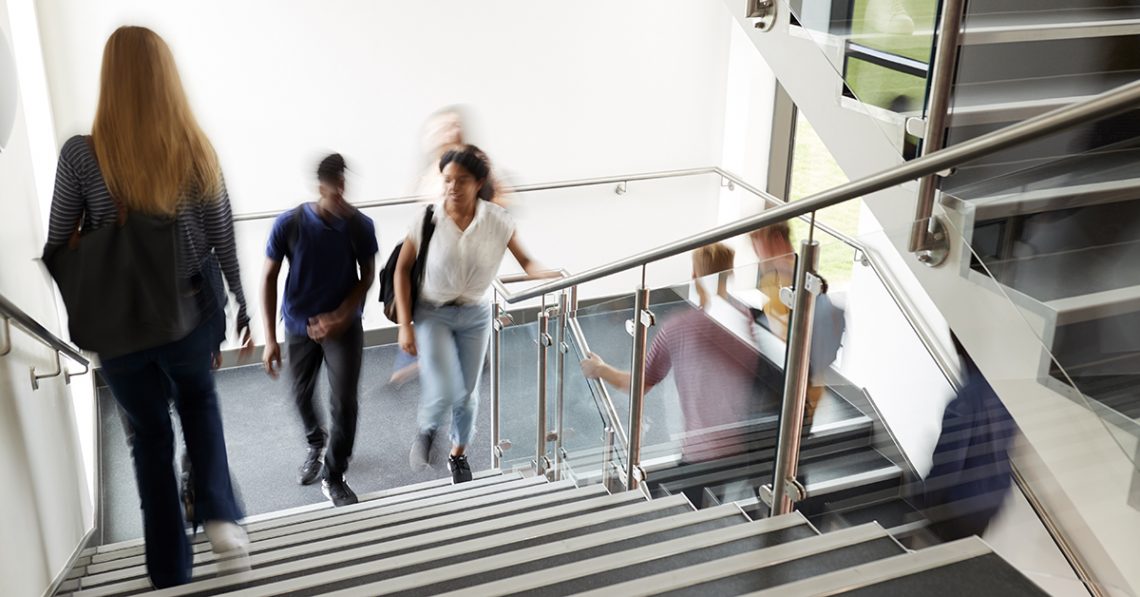
Key points:
• Falls on stairs are common, and often lead to serious injuries.
• Falls on stairs are often complex – there are multiple possible factors that can cause a fall.
• Many stair incidents can easily be prevented, and remedial solutions implemented at minimal cost.
• Ultimately, however, steps and stairs should be designed and built properly, consistent with regulations and common practice, having regard for their purpose and use.
The ubiquitous steps and stairs found in all places of the community present a common fall risk. Each year in Australia, thousands of people are injured in their workplace, home or in a public space due to a fall involving stairs. While most of these injuries are preventable, it remains a fact that such incidents can and do often result in serious injuries or even death.
There are a number of factors that may contribute to a fall on stairs, including design, construction and use. This article will outline some of those factors to look out for when considering the safety of a set of stairs, and suggest practical ways that you can minimise risk of injury.
This advice is necessarily of a general nature only; we recommend that you obtain expert advice if the risk of a fall incident is high. If you are a manager or business owner, it is your legal responsibility to make sure stairs in your workplace are as safe as is reasonably practicable for you to make them.
What commonly causes falls on stairs?
Most falls on stairs occur due to one of the following:
- Slips occur when a person loses traction with the stair surface. The most common causes of slips, therefore, are insufficiently slip-resistant tread surfaces (e.g., surfaces that are highly polished, wet, worn carpet, smooth paint or greasy).
- Tripping occurs when a person unexpectedly catches their foot on part of the stairs. Typically, the objects that a stair user will trip on are small and unobtrusive such as a small lip, or a damaged “nosing” (the step edge). A trip can also occur due to inconsistent step sizing – we rely on uniformity in stairs, and can literally be “tripped up” when it is not provided.
- Mis-stepping occurs when a person oversteps a step or otherwise does not land one of their feet on the next level in the position expected. Our gait (the study of how we walk) is a fragile thing, and it is surprisingly easy to disturb it. Such mis-stepping incidents can often also occur due to dimensional inconsistencies, lack of contrast at the step edges, visual or lighting issues. They can also be caused by damaged steps or poorly maintained steps.
How to minimise slip, trips and falls on stairs
To minimise the risk of a slip or trip and fall on stairs, below are some key things to consider about stair safety, whether it is in a home, workplace or community space.
- Step geometry, the dimension of riser and goings (see diagram below) should be within acceptable limits – the National Construction Code provides a useful table of advice in this regard. “Riser and going” (step rise and run) dimensions should be constant through the flight.
- Is the stairway/stairwell well lit? Long established Australian Standards for lighting provide guidance for a whole host of usage situations.
- Is there good contrast along each the step edge? Is it easy to see that there is a step, and where it’s edge is?
- Is the surface material on the stairs slippery in either wet or dry conditions? Is it exposed to an area likely to get wet or greasy? Is it worn or contaminated with some other material, like powders? Are there surface irregularities? Does it give good traction? Australian Standards for surface slip resistance prescribe minimum requirements for surface coefficients.
- Is the nosing (the front edge of the step, see Figure 1 below) worn, raised and lifted (if there is a strip added) or showing signs of wear? Are there areas where a stair user’s toe or heel could catch?
- Are there handrails? Do they extend the full length of the stairs?
- Avoid single steps where possible – they can hide in plain sight.
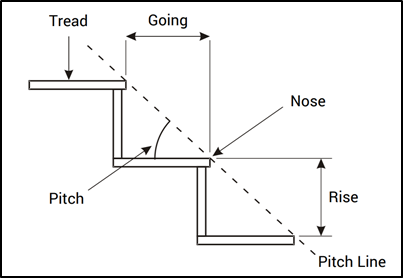
Figure 1 – typical stair properties.
There are other behavioural factors that contribute to falls on stairs, like user fatigue, drug and alcohol use, distraction, carrying heavy or large loads, or sun in the eyes.
As independent safety and ergonomics experts, Dohrmann Consulting have investigated a diverse range of incidents involving stairs, and have also worked extensively with stair designers in ensuring designs meet the appropriate building codes and standards.
We leverage our experience gained from regularly providing expert opinion in stair incidents.
Free ‘Falls on Stairs’ Checklist
We have developed a ‘Falls on Stairs’ checklist that is intended to provide an investigator with guidance as to what to look for and what to ask an injured person when a fall on stairs has occurred. To obtain a copy of this checklist, please click here .
Download Falls on Stairs checklist
You may also be interested in the following information and resources:
- National Construction Code (NCC) Compliance: Expert Safety Advice and Performance Solutions
- Preliminary expert liability advice for legal practitioners
- How to minimise the most common workplace injuries in Australia
Discuss your requirements with an expert – obligation free.
- Like
- Tweet
Related Stories

The Role of Human Factors Specialists in Modern Design.
03 may, 2024.
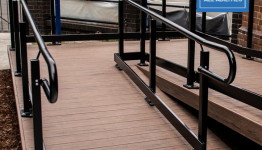
A Guide to achieving Compliance with NCC Performance Requirements.
06 december, 2023.
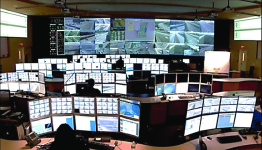
Ergonomic design of Control Centres
27 september, 2023.

Human Factors & Ergonomics in Aviation Maintenance.
13 july, 2023.

Why we do not recommend ‘how to lift’ training.
25 january, 2023.

Engaging a safety specialist to minimise and manage risks.
10 november, 2022.

Mark Dohrmann AM – Appointed a Fellow of Human Factors & Ergonomics Society of Australia (HFESA).
19 october, 2022.
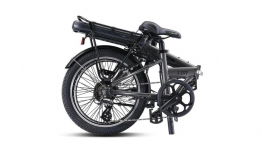
Assessing a product failure: Determining liability
10 october, 2022.
Falling Over and the Metaphysical Reason Behind It
Owner at http://tammymoir.com/
A trip, a stumble or falling down a few stairs, not enough to seriously put you out, but enough to send a little shock wave through your system when you need it. Which is precisely what these things are intended for, a little shake up to alter your mind space to get you out of a habit or pattern of behavior that has become dull and unproductive but hard to change.
The universe has a way of helping you to realign things by creating opportunities to bring you back to your senses.
The times when you might catch your own foot or trip over a crack in the concrete, can predominantly happen when you are too preoccupied with what other people might be thinking of you at that particular moment. How often have you experienced it yourself or seen it first hand, walking past someone on the street, and just for a moment giving your physical appearance or manner too much thought, and whoops, you trip, just to put things back into perspective. Life is much more than just outward appearances, and tripping like this, is a small reminder that you have perhaps been making things all about you and how you appear, when there is a much bigger picture at play. It is a reminder to give, to smile, inwardly and outwardly, it's not about how you look or how you appear on the outside, it's only ever about what you give, and a smile is something that immediately makes the world a better place, always.
Falling down a few stairs can occur when you need a little shake up to get you out of a mental rut. It is showing you that you are heading towards a potentially negative downward spiral, and that if you don't change things, you could continue to keep going down a path that is not best suited for you. Hurting yourself in such a way that makes any pain linger around for a few days, is a way to remind you of why you fell in the first place, it helps to keep a new found alertness in place, so that you can put a more positive spin on your day and to your thought processes over all.
Tripping up the stairs is a sign that you are rushing too fast ahead of yourself and not taking enough care to focus on one thing at a time. This is a way of slowing yourself and your thought processes down, so that you can be total in the moment, and give each and every part of your day the kind of attention that it deserves.
Popular in the Community
From our partner, huffpost shopping’s best finds, more in life.

Watch our videos
254,000 subscribers

Join the conversation
134,000 followers

Pin our posts
25,200 followers

Get our newsletter
88,500 subscribers
- Hearing-Aids
- Healthy Aging
- Losing Weight
- Medical Issues
- Reducing Stress
- Brain Health
- Solo Travel
- Travel Tips
- Small Business
- Part-time Jobs
- Encore Careers
- Managing Money
- End of Life Planning
- Retirement Tips
- Senior Living
- Journal Writing
- Entertainment
- Inspiration
- Empowerment
- Getting Older
- Reinvention
- Giving Back
- Dating Advice
- Online Dating
- Adult Children
- Grandchildren
- Estrangement
- Arts and Crafts
- Piano Lessons
- Photography

Walking Well: How to Avoid Tripping on Uneven Ground or Broken Paving (VIDEO)
Would you like to feel more confident walking? Have you noticed that you walk more slowly or cautiously? Do you sometimes feel unsteady and find yourself tripping on uneven ground or broken paving stones?
If you’re starting to notice your balance when you walk, you’ll know that this can affect your enjoyment of walking.
As a specialist exercise instructor for more than 15 years, I’ve helped hundreds of people to feel steadier on their feet and more confident with their walking.
I know how vital walking well is, and that’s why I’ve written this series of articles for Sixty and Me. The series focuses on Looking Ahead , Posture , Arm Swings and Taking Big Strides .
If you’re starting to notice your balance when you walk and would like to feel more confident, keep reading!
Firstly, What Is Walking Well?
You probably learnt to walk 60 or 70 years ago and haven’t given it much thought since. It’s just something we do every day! So, thinking about how you walk is strange, and the idea of practising walking will seem quite odd.
However, if you don’t feel as steady as you used to, you will benefit from paying attention to how you walk.
Walking Well means thinking about our posture, about what our arms and legs are doing and where we are looking when we walk. This series of walking well articles and videos will help you (re)learn some of the things that help us walk confidently and safely.
Why Does Walking Well Matter So Much?
When we feel confident walking, everyday life is easier and more enjoyable. We can get where we need to go, run errands we need to do and walk for pleasure.
We can enjoy our surroundings and companions because we aren’t worrying or feeling unsteady.
Walking well allows us to enjoy spending time with our friends and family, exploring new places and connecting with nature. It gets us out of the house and can help to reduce stress and anxiety.
It matters because if we aren’t walking well, we’re at risk of trips and falls. The consequences of a trip or fall can range from bruised limbs (and confidence) to broken bones, time in hospital and surgery.
I also think it’s crucial for how we feel about ourselves. When we feel confident doing the things we want and need to do every day, we feel better about ourselves. We also tend to feel more optimistic about the future.

What Do We Do with Our Feet When We Walk?
In previous articles and videos, I’ve covered several elements of walking (including posture and arms). Today, I’m going to focus on what we do with our feet when we walk.
I know that sounds funny; it’s obvious, right? We just put them on the ground! However, the way we place our feet on the ground can make a big difference to how well we walk.
Watch this demonstration video to learn more about foot placement when walking. Be ready to get up and practice with me!
Foot Placement Demonstration
Practice this now. You’ll notice how much more powerful your walking feels when you roll through your foot with the heel-toe motion.
Then, next time you’re out walking, try and remember to think about how your feet are landing and pushing off from the ground. You’ll feel more confident (and be much less likely to trip on uneven ground or broken pavements).
Exercising for Walking Well
As well as paying attention to our walking technique, doing exercises to improve our strength, balance and posture will help us walk better.
We know that a combination of strength and balance exercises will help to improve our balance and reduce our risk of trips and falls. So, if you aren’t already doing so, consider adding regular strength and balance training to your routine.
Many people think that starting an exercise programme involves hours of leaping around in tight, shiny clothes while someone shouts at you. If that’s what you want, go for it! However, it doesn’t have to be that way.
You can get stronger and improve your balance in just 10-15 minutes a day. You get the best results when you’re doing exercises that are right for you (not ones designed for a 25-year-old who can do handstands!).
A good instructor will encourage you to work at the right pace for you and demonstrate the exercises clearly so you feel confident doing the exercises that will help you.
If you want help and support to exercise at home, take a look at the Vida Wellness Studio . It’s an online exercise studio for people who want to improve their balance and posture, feel stronger, and move more easily. Our videos are clear and easy to follow, and most of our routines are 10-15 minutes long, so you can easily fit them into your day.
Do you notice your balance when you walk? Have you ever considered concentrating on how you move your feet? Do you often trip on uneven ground? How does it feel when you practice this heel/toe motion? Join the conversation below!
This site uses Akismet to reduce spam. Learn how your comment data is processed .
Tags Fitness Over 60 Healthy Aging
Claudine Aherne
Over the last 16 years, Claudine has helped hundreds of people to improve their balance, feel stronger and move more easily. That's why her in-person classes and online programmes have been featured globally, including on BBC Radio 4. Members of her online exercise studio enjoy an extensive library of easy-to-follow videos, as well as advice and support. Try some taster videos from the Vida Wellness Studio .
You Might Also Like
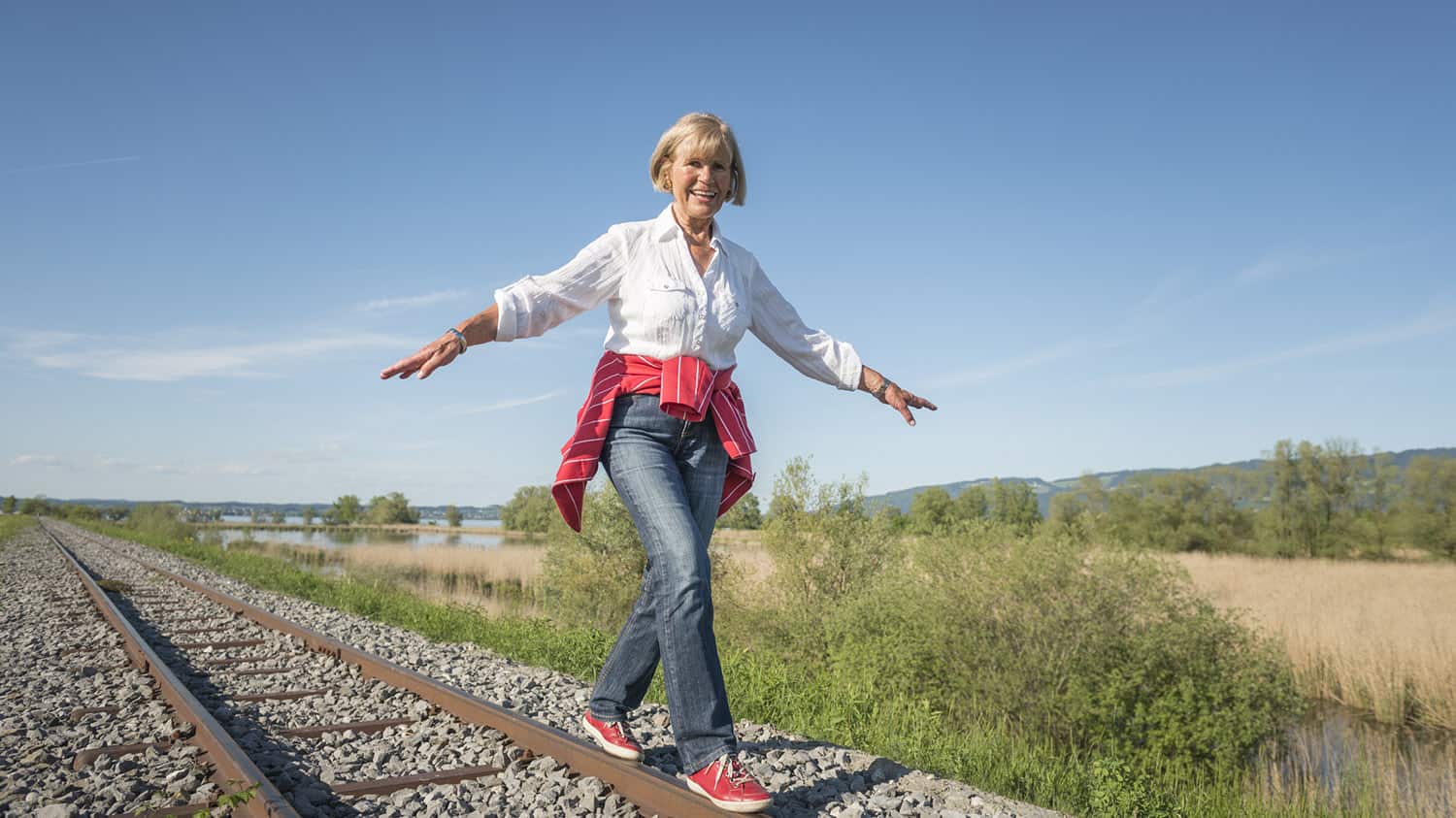
6 Simple Ways to Improve Your Balance After 50

3 Ways to Biohack Your Health and Find New Energy After 60
print this page Print this page
- Home New Posts Forum List Trending New Threads New Media Spy
- WikiPost Latest summaries Watched WikiPosts
- Support FAQ and Rules Contact Us
Do you misstep going UP stairs or DOWN?
- Thread starter Leareth
- Start date Sep 13, 2009
- Sort by reaction score
- MacRumors Community
- Community Discussion
Do you misstep more going DOWN, UP or roughly same on stairs.
Both equally.
- Total voters 46
macrumors 68000
- Sep 13, 2009
I have noticed that when going up stairs I rarely trip , but when walking down stairs 1/3 of the time I misstep. It is so bad that I take the elevator DOWN. Just wondering if there are other people who misstep more often going down stairs than up.
dukebound85
Macrumors core.
going up moreso for me
macrumors regular
people have really run out of things to talk about on here haven't they.
dukebound85 said: going up moreso for me Click to expand...
Jhanson09 said: people have really run out of things to talk about on here haven't they. Click to expand...
macrumors 68030
I misstep up occasionally, but I don't think I ever misstep down.
i love when i reach the bottom of stairs but dont realize it and expect another step and therefore kinds stumble lol
macrumors 65816
macrumors 601
dukebound85 said: i love when i reach the bottom of stairs but dont realize it and expect another step and therefore kinds stumble lol Click to expand...
macrumors 68040
I've tripped up the stairs probably three times more often then taken a misstep going down. I have a bad knee (with surgery), but I will more likely trip up. That's been for my whole life. Now that I have MS, though, I find myself being less steady going down too. That's a bit more scary, because I feel like I could do more damage if I fell down than up.
dmmcintyre3
Macrumors 68020.
Up, I can go up and skip steps on purpose without issue, down I can skip steps and 99% of the time I am fine.
redking31591
Macrumors 6502.
up stairs
iBookG4user
Macrumors 604.
Most of the time it would be going up the stairs. I have a habit of going up the stairs at the edges of steps, so sometimes my feet will slip.
electroshock
Macrumors 6502a, littleman23408.
I mis-step going up only if i am taking my time. But if I am rushing up the stairs at a fast pace, i dont mis-step. When I go down, i never mis-step.
Kaleidoscope1
Macrumors newbie.
- Jul 26, 2014
Have noticed that I am more likely to trip going up stairs if I am wearing something long (e.g. dressing-gown/ robe) which flaps about my legs -think the motion of this causes some kind of visual confusion for me about which leg is where!
The Doctor11
Macrumors 603.
Kaleidoscope1 said: Have noticed that I am more likely to trip going up stairs if I am wearing something long (e.g. dressing-gown/ robe) which flaps about my legs -think the motion of this causes some kind of visual confusion for me about which leg is where! Click to expand...
- Jul 27, 2014
ucfgrad93 said: Oddly enough, I too miss more steps going up than down. Click to expand...
macrumors G3
Definitely down. I have bad knees so down/declines (or uneven surfaces) can be difficult.
Jessica Lares
I've noticed on certain types of floors (smooth tile) I have a tendency not to pick my feet up enough tripping every so often. Stairs don't seem to be a problem. Where is the "neither" option?
thatoneguy82
- Jul 28, 2014

Chronically missing stairs and losing balance
The Forums › Forums › What is it? › Odd Symptoms/Behaviours/Signs › Chronically missing stairs and losing balance
- Author Posts
Does anyone else chronically miss the last or second to last stair? It’s like my brain is getting ready to transition from stairs to flat, and I misjudge how far the stair is. I’ve nearly killed myself (and others) doing this, so I take the elevator now.
I fall upstairs all the time. I tentatively place my foot down when I feel I am coming to the last stair because I have fallen up or down the stairs a lot. I also always seem to stumble in the crack of sidewalks and fall off curbs. My doctor told me that I have poor situational balance. I completely lose sight of where I am and misjudge distances. My friends also scolded me a lot growing up of walking on them or bumping into them. I could never walk in a straight line, I always tended to end up walking into them. In the winter especially I spend a lot of time falling on the ice. I also have turned my ankle dozens of times just by putting my feet down wrong. When driving I tend to ride the inner line of the lane.
me too, maybe its because we are all in a hurry.or are we all just not watching were we are going. or am i the only one that is always in a hurry.
me too, maybe its because we are all in a hurry.or are we all just not watching were we are going. or am i the only one that is always in a hurry. i was going to post this and my computer said slow down you move to fast.lol
me too, maybe its because we are all in a hurry.or are we all just not watching were we are going. or am i the only one that is always in a hurry. i was going to post this and my computer said slow down you move to fast.lol. still in to much of a hurry sorry.
I guess we found another “feature” of ADD. @curlymoe, I’ve had a high ankle sprain for 10 years now; chronic. I like to say I injured it in an argument with a flight of stairs. (Of course, the ADD means icing it properly was not really possible: “has it been 20 minutes yet? Am I doing this right? Why do we say right to mean correct? Why not left? Is it political? And why is it called politics? Doesn’t poly mean many? So is it a lot of tics? So politics is a bunch of blood sucking creatures! hahahah—why is my leg cold?)
I’ve been walking more carefully now, and focusing on where I put my foot. I too kept walking awkwardly, running into people. It’s gotten better in just a few days. I think knowing that it’s the ADD helps to manage it–I don’t feel helpless anymore.
Oh, and the timer on the iPhone is a godsend.
I’m always in a hurry and do it all the time. Usually escape with just embarrassment, but once broke my leg in the ankle. Of course it’s never the same again. Grrrr…..
my 3 year old was taken away from me monday .. child protection agency believe im a drunk because for last 18 months of approx 50 ‘UNPLANNED VISITs’ :ive nearly always been staggering about tripping over things and slurring my words .even tho im diagnosed aadd .. they think my doc talks bull.. wen he tells them its normal especially under stress even tho he is their consultant spsychatrist in psychotherapy .. .. no shit
I don’t know whether it is a lot more common, in reality, for Social Services to take more of an interest in us and our kids. When mine were little they always came sniffing around. When Pigpen was older and we went asking them for help they were less then helpful. They finally decided that the best thing was if she left home and went to live with her grandfather because he was 2000 miles away from the trouble she was in. They had no programs for teen girls in Alberta, lots of programs for teen boys. A lot of ADD and ADHD people I know have a lot of Social workers coming around. You should insist that they administer a drug test instead of just accusing you. I trip over my own feet. Good luck dealing with these people. Most of them come from troubled backgrounds themselves so they often see the boogie man where none exists, and then they work with true abusers for months and years longer then these children should be there.
There are several reasons for this for me:
* ADHD – I lose concentration of what I’m doing (up or down stairs, I daydream) I often miss steps
* My vision – bifocals don’t help!
* My Meniere’s – pretty severe at times, I can fall down on a level floor. I’m on meds for that, and had to take some therapy sessions to teach my brain how to compensate. Looking down the aisles in a store can make me dizzy.
*This bloody @#%$@#$ strattera! Man this stuff is nasty!
Let’s see – split knee cap in half
Broken little toes at least 3 times
got hand in table saw, nearly lost index finger and thumb on left hand (I’m left handed)
several car accidents (one with broken collar bone)
torn bicep tendon (ripped it off the bone – yeah, my left arm again)
Is it me, or ADHD? Mom always said i was a very clumsy kid.
Now something to make you feel a bit better – my cat Yawnie loves to race us up and down stairs. One day I made a move to the stairs leading to the main floor but changed my mind. Yawnie got a good head start 15 feet behind me, ran to the stairs at full tilt, made the first two, missed the next, flipped and slammed his head into the next step, flew into the next with his back, and fell back down limp and twisted. He was out for a few seconds. He literally bruised a kidney, smacked his back and suffered head trauma.
So if a CAT, the sleek talented athlete of the animal world can do such things………. don’t feel badly if you miss a step or two.
I never even considered this before! Although I don’t chronically miss steps now I am very paranoid about the top step. As a kid I remember numerous sprained ankles, twisted knees, torn cartilage. Now that i think about it in 7th grade i misjudged a step and ended up taking 3 at time going down and sprained my ankle. I was always coming up with new bruises and not remembering where I got them. I broke a finger and sprained the one next to it because I insisted on running down a just waxed hallway at a school and landed on my hand. I cut a finger to the bone trying to cut stuff off a ring that I had used to keep the ring from falling off. I stood on a folding chair to fix a party decoration at my brother’s wedding and had the chair fold up on my foot and broke a bone. I am always burning myself when I cook. I hate to cook. I don’t sprain ankles anymore because I walk with a cane now but I still burn myself all the time when I cook.
A couple of years ago I tried to separate two extension cords with a pair of scissors WHILE THEY WERE STILL PLUGGED IN! My daughter witnessed that one. Fortunately the scissors had a plastic handle so it was just sparks and a damaged pair of scissors but to this day I keep telling myself I know better than to do that. I know there are many other incidents of clumsy, downright dangerous behavior that I can’t recall at the moment.
I just never linked this to my ADD before.
Should I be linking this with ADD?
@faeirynuff do you have legal help? This sounds like a legal issue. I may have a solution for you if you dont already have a lawyer but I want to check with the site managers to see if its ok to post this information.
I think inattention to detail is definitely connected to ADD as well as doing things without fully thinking through the consequences. We are always in such a hurry to complete the job we rarely think logically through the steps to get the job done. A plugged in extension cord being cut could potentially have killed you or at least seriously hurt you. Looking back you see the error of this but at the time didn’t it just seem expedient to get it done. We also get distracted so we reach for something without even thinking about it, or grab it with a cloth that isn’t appropriate for the task.
It’s in the possible symptoms list here on this site – as well as several others related to ADD/ADHD and job performance, etc.
Why do you fall going up the stairs and not down the stairs?
A lot of people ask that question, but people usually fall while going up the stairs rather then going down the stairs mainly because they do not lift their leg up high enough.
Add your answer:
In The Aristocats why do Edgars pants randomly fall down when he announces Georges arrival to Adelaide?
George pulled Edgars bracers down when he hooked them with his cane going up the stairs!
How do you get all the way up the stairs?
I always do the right side for up and left for down
Is it illegal for a teacher to make their students run up and down stairs?
No the teachers are in charge after a principle plus it is exercise.
What is the song playing in the Pixar movie UP when Mr Fredrickson is coming down the stairs very slowly?
Habanera from the french opera Carmen by Bizet
On Friends what was Chandler's response when Ross kept on repeating the word pivot?
Ross: Oh yeah it will! Come on, up! Up-up-up! Up! Yes! Here we go! Pivot!(They start up the stairs again. Chandler is between the couch and thewall now.) Pivot! Piv-ot! Piv-et!! Piv-ett!!! Piv-et!Chandler: Shut up! Shut up! Shut up!!(They set the couch down.)Ross: Okay, I don't think it's going to pivot anymore.Chandler and Rachel: You think?!
Do people fall going upstairs?
Yes, accidental falls going up stairs are very common. However once the fall has begun gravity will pull the victim down the stairs!
What goes up and down without moving-?
The answer to this riddle is "a staircase". Of course the staircase does not actually move up and down, but when you refer to a staircase directionally, you are either going "up the stairs" or "down the stairs". Its function in and of itself is to "go" up and down.
Why is it harder to walk up stairs than to walk down stairs?
cause when you walk up it is easy and it is hard to walk down cause you can fall
Why do your knees hurt when you run or walk down stairs but not when you walk up stairs?
More bone usage going down, More musle usage going up.
What pram is best for going up and down stairs?
Theres an invention on strollersandprams.com that sits under a pram and you can slide up or down stairs.
Why does it hurt dogs to go up stairs but not down stairs?
their bodies arent used to going up steps and rocks
Can you go back down the notre dame stairs as in the same ones you came up?
No. There are separate stairs for going up and down. The staircase is extremely narrow, it would be impossible to have people going both up and down on the same one.
What was a spiral staircase used for?
To go up and down stairs. And to fall over. NANA
Is it possible to fall up stairs?
Yes, it is. When people trip on a step while going up, that is called 'falling up'.People often misjudge the amount of steps in a staircase. Since most don't look down, they trip over their feet.Agreed, it *is* possible to fall while going up the stairs...I just want to clarify the terminology :)Unless it's a part of speech that i never learned, I have never used the term "falling up".Whenever I(or anyone else that I have ever known, for that matter) have tripped or fallen while going uphill or upstairs, I've always only ever heard the term:"I fell down going up(the stairs/hill, etc)"or "I fell going up", or something to that extentI have *never* heard anyone use the term "falling up" or the phrase "I fell up" or "I fell up the stairs"(but again, that might be just me )In this light, i believe "falling" is the act of succumbing to the force of Gravity, which in almost all cases means "falling down"(not "falling up", which would be floating).i have fallen up stairs many times so yes you can fall up stairs
Why do we have to use more effort to climb up a flight of stairs as compared to when we go down the stairs?
Going up, you have to overcome gravity with every step.
How do you get to the sick Pokemon in hg?
If you are talking about the Ampharos in the lighthouse in olivine city, then you must work your way up though the stairs. the stairs start next to the elevator on F1. On one of the floors however, there apear to be no ladder going up, you then must search for an exit whear you will fall down to the oustside of the Light house and enter again, NOTE you do not fall all the way down, only to a lower floor.
Top Categories

Ohio State nav bar
The Ohio State University
- BuckeyeLink
- Find People
- Search Ohio State
Why Were The Stairs Warped?

Staircase in a prison block (Simon Norfolk – Auschwitz)
The tour guide at Auschwitz I took our group into block 4, and I was hyper aware of everything since it was the first block I’d ever been in. Maybe I was extremely dramatic, which was definitely self-inflicted, but I was afraid to breathe the air in there. Afraid that the air would tell me something sinister that I didn’t know about Auschwitz yet. First of all, air doesn’t necessarily have a voice, at least as far as I am concerned. But that doesn’t mean that air can’t. Stay with me, Reader, I am a unique writer without any formal training. I can’t remember what we saw or what the tour guide talked about throughout the block because on my left, at the end of a hallway, were a set of marble stairs. I was struck by the oddness of each step that led to the 2nd level; each step of marble was warped. Warped in the way that very thin metal bends, but each step was made of hard marble, and two directions of wear were present. Throughout the stairs’ lifetime, they’d been traveled up and down a lot. As worn down as they are, it’s possible that visitors have carved the marble overtime. It’s possible that the stairs had been subjected to the wear of even the Polish soldiers who had utilized the building before Nazi prisoner’s ever had.
To me, the stairs symbolize many things, but I want to draw attention to them as a symbol of the history of World War II. Pay no attention to the up-and-down directions that stairs mean. Focus on the plains and valleys of a single step. The plain of marble symbolizes the general history of the era, so the textbook lessons that I read throughout my K-12 education. These lessons are introductory, and they state factual history without any primary sources. On the step, there are two sides that are incredibly worn down. They slope upwards towards the middle of the step where the marble is level. Let’s say that the right slope symbolizes the written and oral experiences of the survivors and victims who were persecuted by the Nazis. Their stories alter the factual history in grade school textbooks by breaking down the general facts, exposing the layers of how scary and sad being on the receiving end of Nazi atrocities was. Once the graphic details are revealed, you can never forget them. For me, the most shocking details are of the starvation of prisoners (Elie Weisel, Night, 100-102), the humiliation of Jews forced to scrub streets with their bare hands (Dokumentationsarchiv des Oesterreichischen, USHMM), and the picture of a Ukrainian Jew kneeling at the edge of a mass grave where he’d fall forward into the grave after he was shot (USHMM). Knowing these details have worn on me overtime because they have been useful in my own attempt at understanding of the magnanimity of the Holocaust specifically. They are the steps that I take to asking deeper, more complex questions about history. Without them, no one would truly know what happened during that time.
In the left valley on the marble steps, I can insert anything, such as the experiences of Nazi soldiers. This can be frustrating if you don’t understand why reading and listening to their experiences, especially parallel to their victims’, is important to fully understanding the context in which they operated.
Hopefully you see now why the warped stairs in block 4 gained my attention. Bringing the up-and-down aspect of them back into this discussion, going up the steps can be hard, but so can going down them. Learning the history of World War II can be hard and intense, and sometimes easy, but every step is important because it holds stories and experiences that no one would know if they were not investigated. Look around. The most obvious, seemingly uninteresting objects may have the most stories to tell.
By Isabella Scully-Tenpenny
Leave a Reply Cancel reply
Your email address will not be published. Required fields are marked *
Trump campaign doubles previous one-day record fundraising haul after guilty verdict
Former President Donald Trump's campaign says it raised a whopping $34.8 million in small dollar donations after he was convicted Thursday on 34 felony counts in Manhattan.
The campaign said the Thursday haul was "the biggest day ever recorded" for Trump's vaunted small-dollar fundraising operation on the WinRed platform, nearly doubling the previous high. The WinRed website temporarily crashed from the overwhelming traffic.
In a statement Friday morning, senior campaign advisers Susie Wiles and Chris LaCivita said that within minutes of the verdict "our digital fundraising system was overwhelmed with support, and despite temporary delays online because of the amount of traffic, President Trump raised $34.8 million dollars from small dollar donors."
"Not only was the amount historic, but 29.7% of yesterday's donor's were brand new donors to the WinRed platform," the statement added.
Trump was found guilty in New York state court of falsifying business records to cover up hush money payments to a porn star to conceal an alleged affair. He was found to have done so to hide another crime, such as a campaign finance law violation or a tax code violation, making the charges felonies. He will be sentenced on July 11 and he could face probation, community service or a short jail stint.
Prep for the polls: See who is running for president and compare where they stand on key issues in our Voter Guide
An aggressive Trump campaign effort to capitalize on the conviction
Trump’s campaign texted supporters at least five times asking them to donate and sharing a link to a WinRed page that called Trump a “political prisoner,” framed his conviction as a “witch hunt,” and included a copy of his mugshot from an unrelated case in Atlanta, Georgia. The page asked 10 million people to donate.
Additionally, dozens of Trump's allies shared the same link to the WinRed page on X, formerly known as Twitter. They include Republican Sens. Katie Britt of Alabama, Marco Rubio of Florida, J.D. Vance of Ohio, Tim Scott of South Carolina and Marsha Blackburn of Tennessee. Reps. Elise Stefanik of New York, Byron Donalds of Florida and Steve Scalise of Louisiana also shared.
More: 'Speechless': Swing state voters react to Donald Trump's guilty verdict
Trump’s campaign wrote on Truth Social less than an hour after the verdict was announced, “So many Americans were moved to donate to President Trump’s campaign that the WinRed pages went down. "We are working on getting the website back online as quickly as possible.”
USA TODAY's inquiry to WinRed was not immediately returned.
Small-dollar donations often can be a measure of grassroots enthusiasm for a candidate. In Trump's case, they have been a barometer for how the GOP base is responding to his legal troubles.
Trump has used each of his four criminal indictments to raise money, but his first conviction gave his fundraising a bigger boost.

IMAGES
VIDEO
COMMENTS
And most days, everything comes together in perfect harmony — so when we start to falter, to trip up the stairs or bump into tables or to drop our keys on our front porch, it can be cause for alarm.
There are several factors that can contribute to frequent tripping while walking. Some of the common causes include: Muscle weakness: Weak muscles, particularly in the legs and feet, can lead to instability and tripping. Poor balance: Lack of balance can make it difficult to maintain steady movements and increase the risk of tripping.
How people walk up and down stairs: Stair slip trip & fall hazards and their prevention may benefit from a look at just how people step when ascending and descending stairs and what they do with handrailings or where they place their hands when there is no handrail. Stair tread & step construction or maintenance mistakes can create a wide range ...
Being able to walk up the stairs requires muscular strength, endurance, mobility, coordination and balance. In other words, your lower-body muscles have a lot going on at one time. If you feel weak and/or unsteady on your feet or experience pain in the knees, hips or ankles, you may need to strengthen a few parts of your body and focus on ...
Also clean up any spills or other messes you see on the stairs as soon as possible to keep the steps safe. [9] Make sure nothing is loose or sticking out of stairs, such as loose boards, nails or other building debris. Avoid placing loose rugs at the top or bottom of stairs. These may shift and result in falls. 3.
Why Only 2% of Us Take the Stairs. ... If you want to get serious: "A good beginner workout would be to walk up the stairs nonstop for about 20 floors using the handrail," said Soh. "When ...
The nosing of the stairs is often the danger area of the staircase. Many people trip over this part of the stairs because they fail to gauge its distance from them. Some experts say that one of the probable reasons for this is that some stairs are uniformed in colour, making it hard to see clearly the nosing. Paint the nosing a different colour ...
This is a short video of a set of subway stairs in Brooklyn where one of the steps is juuuust a bit taller than the rest, which makes most people trip on it. We don't often think about it but even the least graceful humans move in a finely calibrated way. When we're climbing stairs, our feet don't clear the treads by much, so that even ...
The best way to prevent injuries due to slips, trips, and falls on outdoor stairways and steps is to install anti-slip products that will help provide continuous traction. HandiTreads are a permanent anti-slip solution that provides slip, trip, and fall prevention in virtually any weather condition. With their patented raised-button traction ...
10 Crucial Stair Safety Tips. 1. Keep Stairs Clear. Maintain Clear Stairs Make sure there are no obstructions, mess, or debris on the staircase. Toys, shoes, and other objects that could cause a trip are all included in this. Users have a safe path and a lower chance of accidents when there is a clear staircase.
Vertical heterophoria (VH) is a binocular vision dysfunction that affects how the eyes work together as a team. With VH, the vertical alignment of the eyes is off-kilter, with one of them being higher than the other. This makes it extremely hard for the eyes to focus on the same place, resulting in poor stereo vision (the combining of two ...
Back-up power is especially critical for stairway lighting. Short Stairways. A significant number of "air step" falls - stepping off the top of a stairway into air - occur on low stairways that consist of one, two or three steps. In effect, people step off into thin air, not having seen the stair or stairs at all.
Visibility on stairs. Improving visibility on stairs significantly reduces the risk for common mishaps caused by misjudging distances. Otherwise you can trip on a step or miss it completely. You can catch a heel on the edge of a step. Such mishaps are a routine cause of twisted ankles, sprained knees or more serious injuries incurred by a total ...
A trip can also occur due to inconsistent step sizing - we rely on uniformity in stairs, and can literally be "tripped up" when it is not provided. ... How to minimise slip, trips and falls on stairs. To minimise the risk of a slip or trip and fall on stairs, below are some key things to consider about stair safety, whether it is in a ...
A trip, a stumble or falling down a few stairs, not enough to seriously put you out, but enough to send a little shock wave through your system when you need it. Which is precisely what these things are intended for, a little shake up to alter your mind space to get you out of a habit or pattern of behavior that has become dull and unproductive ...
Photographs of all kinds of stair and step & walk defects illustrate a wide range of causes of falling down the stairs - stair trip and fall hazards and injury sources. Here we discuss and illustrate worn, loose, damaged steps & stair fall hazards. narrow tall stair steps, slippery stair tread surfaces. curved, angled, & winder stair trip ...
People of any age may trip, stumble, or fall. Tripping and stumbling can cause serious falls if the person cannot catch himself before going down to hit the floor or ground. It is more common ...
Walking well allows us to enjoy spending time with our friends and family, exploring new places and connecting with nature. It gets us out of the house and can help to reduce stress and anxiety. It matters because if we aren't walking well, we're at risk of trips and falls. The consequences of a trip or fall can range from bruised limbs ...
Overstepping. While there are plenty of reasons why someone may fall while descending stairs - poor lighting, broken stairs, lack of handrails, etc. - the two primary causes are overstepping and slipping. Overstepping occurs when we can't clearly identify the front of the tread and wind up stepping into the open space in front of the stair.
The steps are more visible going up, which is why you're less likely to have a misstep. I have a hard time using escalators because of the color of them too. Definitely if you can't see well, you're going to have problems going down three flights of pitch black stairs too (which I had to do earlier in the summer).
Going up stairs has to do with strength and being able to clear each stair as the toe of my shoe will 'catch' just below the step. Going down I need to concentrate on foot placement. Neither has anything to do with deep perception, for me. But has everything to do with the ability to lift my feet and the connection as to where my feet are going ...
One day I made a move to the stairs leading to the main floor but changed my mind. Yawnie got a good head start 15 feet behind me, ran to the stairs at full tilt, made the first two, missed the next, flipped and slammed his head into the next step, flew into the next with his back, and fell back down limp and twisted.
Best Answer. A lot of people ask that question, but people usually fall while going up the stairs rather then going down the stairs mainly because they do not lift their leg up high enough. Wiki ...
1. Assess where the squeak is coming from. Understanding where the sound is coming from is essential for providing the correct solution to the problem. As such, your first step when it comes to ...
An inside look at the culture of Rwanda, why gorilla trekking will take your breath away, and how to plan your trip. The battle-worn hippo trotted into the acacia trees, surprisingly light on its ...
That's why it's important for the person in charge to make sure there aren't any jerks on the trip. No one's going to get along 100% of the time, but that doesn't mean you can't try to ...
Warped in the way that very thin metal bends, but each step was made of hard marble, and two directions of wear were present. Throughout the stairs' lifetime, they'd been traveled up and down a lot. As worn down as they are, it's possible that visitors have carved the marble overtime. It's possible that the stairs had been subjected to ...
Here are the 34 business records Trump was found guilty of falsifying, as described in Judge Juan Merchan 's jury instructions: Count 1: Michael Cohen's invoice dated Feb. 14, 2017. Count 2: Entry ...
The Trump campaign said it raised $34.8 million on the small donor platform WinRed after his guilty verdict. The site crashed from the traffic.
Donald Trump became the first U.S. president, current or former, to be convicted of a criminal offense when a 12-person jury in New York on May 30 found him guilty on 34 felony counts of business ...